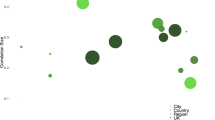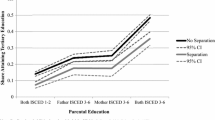Abstract
Although many studies have examined associations between Black single-parent families and their children’s educational achievement, few have considered the longitudinal impact of single- and two-parent Black families. Using a nationally representative sample from the Education Longitudinal Study and a theoretical model of intersectionality, we found that in general, 10 years beyond their sophomore year of high school, (1) female students in single-parent households had better outcomes than did their male counterparts; (2) college social capital and positive class preparedness had a positive impact on educational outcomes for both males and females; (3) the resource dilution hypothesis operated very differently for female versus male students; (4) parental control had a negative impact on males, while cultural capital had a positive impact on both genders; and (5) for both males and females, socioeconomic status had a positive impact on educational outcomes.
Similar content being viewed by others
References
Alexander, M. (2012). The new Jim Crow. New York: New Press.
Amato, P. R., Patterson, S., & Beattie, B. (2015). Single-parent households and children’s educational achievement: a state-level analysis. Social Science Research, 53, 191–202.
Anyon, J. (2014). Radical possibilities (2nd ed.). New York: Routledge.
Aulette, J. (2009). Changing American families. New York: Pearson.
Battle, J., Alderman-Swain, W., & Tyner, R. (2005). Using an intersectionality model to explain the educational outcomes for black students in a variety of family configurations. Race, Gender & Class, 12(1), 126–151.
Billingsley, A. (1992). Climbing jacob’s ladder: the enduring legacy of African-American families. New York: Simon and Schuster.
Bourdieu, P., & Passeron, J. (1977). Reproduction in education, society and culture. Los Angeles: Sage Press.
Brooms, D., Goodman, J., & Clark, J. (2015). We need more of this: engaging Black men on college campuses. College Student Affairs Journal, 33(1), 106–123.
Carter, P. L. (2005). Keepin’ it real. New York: Oxford University Press.
Cherlin, A. (2012). Public and private families (7th ed.). New York: McGraw Hill Education.
Ciabattari, T. (2010). Cultural capital, social capital, and educational inequality. Childhood Education, 87(2), 119–121.
Coleman, J. S. (1988). Social capital in the creation of human capital. American Journal of Sociology, 94, S95–S120.
Coleman, J. S., & Hoffer, T. (1987). Public and private high schools: the impact of communities. New York: Basic Books.
Collins, P. H. (1999). Black feminist thought. New York: Routledge.
Crenshaw, K. (1989). Demarginalizing the intersection of race and sex: a black feminist critique of antidiscrimination doctrine, feminist theory, and antiracist politics. University of Chicago Legal Forum, 1, 139–167.
Darling-Hammond, L. (2015). Flat world and education: how America’s commitment to equity will determine our future. New York: Teachers College Press.
Douglas, D., & Browne, A. (2011). Surviving the downturn: the role of social capital in the financial crisis. Western Journal of Black Studies, 35(2), 128–138.
Dufur, M. J., Parcel, T. L., & Troutman, K. P. (2013). Does capital at home matter more than capital at school? Social capital effects on academic achievement. Research in Social Stratification and Mobility, 31, 1–21.
Edin, K., & Kefalas, M. (2011). Promises I can keep. Berkeley: University of California Press.
Ewell, W. H., & Rodgers, R. R. (2014). Enhancing student preparedness for class through course preparation assignments: preliminary evidence from the classroom. Journal of Political Science Education, 10(2), 204–221.
Franklin, D. L., & James, A. (2015). Ensuring inequality: the structural transformation of the African American family. New York: Oxford University Press.
Gaddis, S. M. (2013). The influence of habitus in the relationship between cultural capital and academic achievement. Social Science Research, 42(1), 1–13.
Gibbs, B., Workman, J., & Downey, D. (2016). The (conditional) resource dilution model: state- and community-level modifications. Demography, 53(3), 723–748.
Goodwin, P., McGill, B., & Chandra, A. (2009). Who marries and when? Age at first marriage in the United States: 2002. NCHS Data Brief, 19, 1–8.
Griffin, K., & Allen, W. (2006). Mo’ money, mo’ problems? High-achieving black high school students’ experiences with resources, racial climate, and resilience. The Journal of Negro Education, 75(3), 478–494.
Hampden-Thompson, G. (2013). Family policy, family structure, and children’s educational achievement. Social Science Research, 42(3), 804–817.
Herrnstein, R. J., & Murray, C. A. (1994). The bell curve. New York: Free Press.
Heuveline, P., Yang, H., & Timberlake, J. M. (2010). It takes a village (perhaps a nation): families, states, and educational achievement. Journal of Marriage and Family, 72, 1362–1376.
Hill, L. (2012). Environmental threats to college counseling strategies in urban high schools: implications for student preparation for college transitions. The Urban Review, 44(1), 36–59.
Hill, L. D., Bregman, A., & Andrade, F. (2015). Social capital for college. Urban Education, 50(3), 316–345.
Hinton, E. (2016). From the war on poverty to the war on crime (2016). Cambridge: Harvard University Press.
Holland, J. (2016. The average black family would need 228 years to build the wealth of a white family today. The nation. Retrieved July 03, 2017, from https://www.thenation.com/article/the-average-black-family-would-need-228-years-to-build-the-wealth-of-a-white-family-today/.
Katznelson, I. (2006). New deal, raw deal. Souls: A Critical Journal of Black Politics, Culture & Society, 8(1), 9–11.
Kozol, J. (2004). Savage inequalities. New York: Harper Perennial.
Lipsitz, G. (1995). The possessive investment in whiteness: racialized social democracy and the “white” problem in American studies. American Quarterly, 47(3), 369–387.
Lopez-Tamayo, R., LaVome Robinson, W., Lambert, S. F., Jason, L. A., & Ialongo, N. S. (2016). Parental monitoring, association with externalized behavior, and academic outcomes in urban African American youth: a moderated mediation analysis. American Journal of Community Psychology, 57, 366–379.
McAdoo, H. P. (2007). Black families (4th ed.). Thousand Oaks: Sage Publications.
McCall, L. (2005). The complexity of intersectionality. Signs, 30(3), 1771–1800.
McLanahan, S., & Percheski, C. (2008). Family structure and the reproduction of inequalities. Annual Review of Sociology, 34(1), 257–276.
McLanahan, S., & Sandefur, G. (1994). Growing up with a single parent: what hurts, what helps. Cambridge: Harvard University Press.
Marable, M. (2007). Race, reform and rebellion (3rd ed.). Jackson: University of Mississippi Press.
Martens, P. J., Chateau, D. G., Burland, E. M., Finlayson, G. S., Smith, M. J., Taylor, C. R., et al. (2014). The effect of neighborhood socioeconomic status on education and health outcomes for children living in social housing. American Journal of Public Health, 104(11), 2103–2113.
Miller-Cribbs, J. E., Cronen, S., Davis, L., & Johnson, S. D. (2002). An exploratory analysis of factors that foster school engagement and completion among African American students. Children and Schools, 24(3), 159–174.
Mishel, L., Bivens, J., Gould, E., & Shierholz, H. (2012). The state of working America (12th ed.). Ithaca: ILR Press.
Morgan, S., & Todd, J. (2009). Intergenerational closure and academic achievement in high school: a new evaluation of Coleman’s conjecture. Sociology of Education, 82(3), 267–285.
Moynihan, D. (1965). The Negro family: the case for national action. Washington, D.C.: Office of Policy Planning and Research, U.S. Department of Labor.
Nash, J. C. (2008). Re-thinking intersectionality. Feminist Review, 89(1), 1–15.
Neubeck, K., & Cazenave, N. (2001). Welfare racism. New York: Routledge.
Oliver, M., & Shapiro, T. (2006). Black wealth white wealth: a new perspective on racial inequality (2nd ed.). New York: Routledge.
Perna, L.W & Titus, M. (2005). The relationship between parental involvement as social capital and college enrollment: an examination of racial/ethnic group differences. The Journal of Higher Education, 76(5), 485–518.
Pettit, B. (2012). Invisible men: mass incarceration and the myth of black progress. New York: Russell Sage Foundation.
Reardon, S. (2003). Sources of educational inequality: the growth of racial/ethnic and socioeconomic test score gaps in kindergarten and first grade (Working Paper 03–05R). University Park: The Pennsylvania State University, Population Research Institute.
Reardon, S., & Baker R. K. (2012). Race, income, and enrollment patterns in highly selective colleges, 1982–2004.Stanford University: Center for Education Policy and Analysis.
Robertson, M. A., & Sgoutas, A. (2012). Thinking beyond the category of sexual identity: at the intersection of sexuality and human trafficking policy. Politics & Gender, 8(3), 421–429.
Shapiro, T. (2017). Toxic inequality: how America’s wealth gap destroys mobility, deepens the racial divide, and threatens our future. New York: Basic Books.
Shipler, D. (2004). The working poor. New York: Knof.
Snyder, T. & Musu-Gillette, L. (2015). Free or reduced price lunch: a proxy for poverty? NCES Blog. April 16, 2015.
Stephan, J. (2013). Social capital and the college enrollment process: how can a school program make a difference? Teachers College Record, 115(4), 1–39.
US Census Bureau of Census. (2015). United States statistical abstract. Washington, D.C: U.S. Printing Office.
Western, B., & Pettit, B. (2002). Beyond crime and punishment: prisons and inequality. Contexts, 1(3), 37–43.
Willie, C. V., & Reddick, R. J. (2010). A new look at black families (6th ed.). New York: Rowman & Littlefield.
Wilson, W. J. (1979). The declining significance of race. Chicago: University of Chicago Press.
Wilson, W. J. (2010). More than just race. New York: Norton.
Wilson, W. J., & Neckerman, K. M. (1986). Poverty and family structure: the widening gap between evidence and public policy issues. In S. Danziger & D. Weinberg (Eds.), Fighting poverty: what works and what doesn’t (pp. 232–259). Cambridge: Harvard University Press.
Author information
Authors and Affiliations
Corresponding author
Rights and permissions
About this article
Cite this article
Browne, A.P., Battle, J. Black Family Structure and Educational Outcomes: the Role of Household Structure and Intersectionality. J Afr Am St 22, 77–93 (2018). https://doi.org/10.1007/s12111-018-9395-7
Published:
Issue Date:
DOI: https://doi.org/10.1007/s12111-018-9395-7




